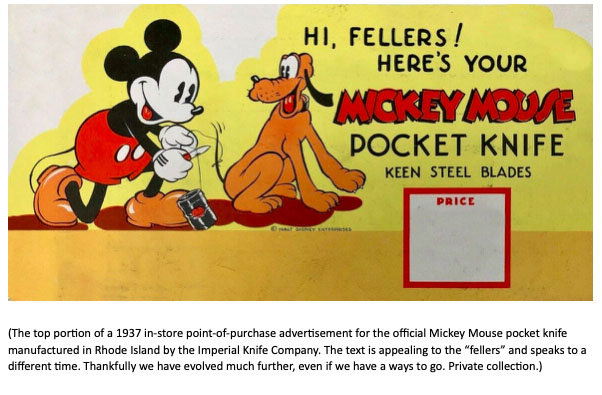 If you were ever involved with a scouting organization or just had a great outdoors kind of childhood, likely at one time or another, you had a pocket knife. Maybe it was a coveted ubiquitous red Swiss Army knife complete with tiny scissors(1) and a plastic toothpick, or it was just a simple canoe style double blade foldout pocket knife with a faux stag antler handle(2).
If you were ever involved with a scouting organization or just had a great outdoors kind of childhood, likely at one time or another, you had a pocket knife. Maybe it was a coveted ubiquitous red Swiss Army knife complete with tiny scissors(1) and a plastic toothpick, or it was just a simple canoe style double blade foldout pocket knife with a faux stag antler handle(2).
These pocket knives are small handy utility tools, some with can or bottle openers, easily transported in a pants pocket. They were never viewed necessarily as a dangerous weapon but more as just a handy tool. It could be produced at a moment’s notice to cut a piece of rope or string, whittle a stick just for the sake of whittling a stick to pass the time, or maybe to carve your initials into the bark of a tree or some other object that you shouldn’t cut.
My brother and I had several different kinds of pocket knives, including our official ones from the Boy Scouts of America. One of our sisters had a Girl Scout pocket knife sporting a teal green handle with a gold scouts emblem embedded. Many branded pocket knives are produced for organizations beyond the Boys and Girls Scouts, businesses like Coca-Cola and Pepsi-Cola, television shows like Walt Disney’s Davy Crockett, and cartoon characters such as Popeye and Mickey Mouse have all adorned pocket knives.
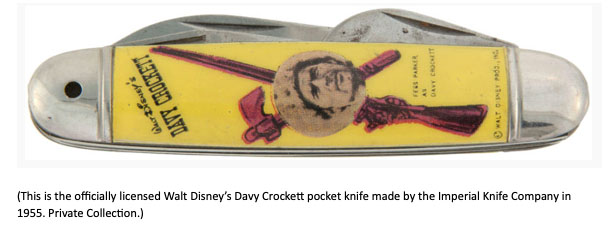
In the 1930s, Disney licensed Mickey Mouse for a pocket knife made by the Imperial Knife Company, at that time located in Providence, Rhode Island. The company made hunting knives, pocket knives, utility knives, and bayonets during much of the 20th century and early 21st century. Through a series of mergers, Imperial Knife Company absorbed smaller competitors and purchased the venerable Schrade Cutlery Company, which became a division of the Imperial Knife Associated Companies group. The company used the Imperial tang stamp up until 1988.
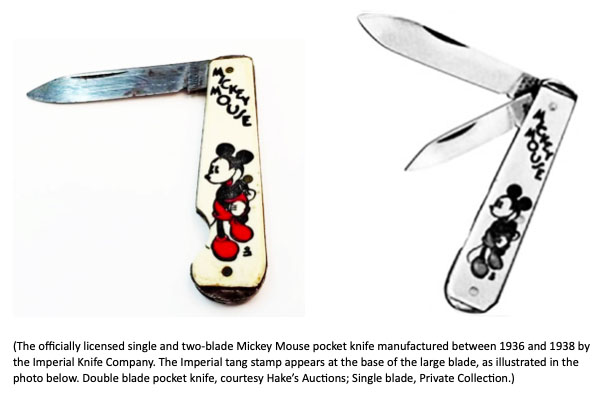
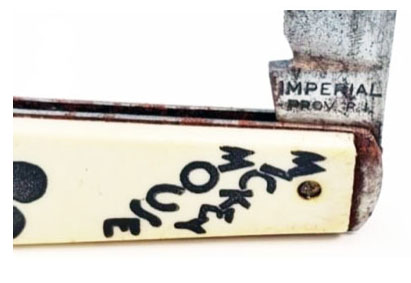
The official Mickey Mouse pocket knives were manufactured as a single blade and a two-blade version from 1936 through 1938.(3) The handle features the text “MICKEY MOUSE” along with a black, white, and red image of the pie-eyed Mickey Mouse character model. There are three rivets visible in the handle that holds the blades, case, and handle parts together.
There are two size varieties; one is three inches long and the other two and three-quarter inches long. On both, to the right of Mickey’s foot, is the copyright, ©WD ENT. (Walt Disney Enterprises). The Disney copyright generally appears on all merchandise, but there are instances where copyright is missing—either left off by mistake or forgotten. The company copyright changed to Walt Disney Productions after 1939 and has changed since to ©Disney and ©Disney Enterprises and the most common.
The Mickey Mouse pocket knives were sold by the dozen wholesale to retail establishments. They came packaged on a point-of-purchase display card with each of twelve pocket knives held in place individually with an elastic band. The top portion of the display was die-cut around an illustration of Mickey Mouse and Pluto. Of course, Mickey is holding one of the pocket knives as he cuts a string tied to a can and Pluto’s tail. Pluto is happily looking on.(4)
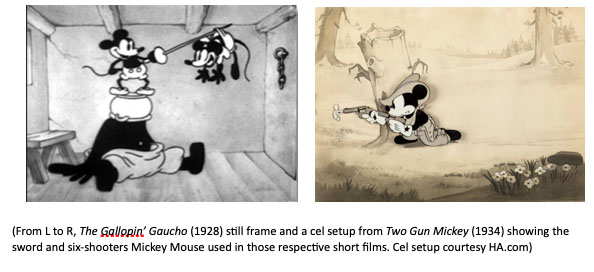
As a side note, Mickey Mouse brandishing any kind of knife today would likely not be permitted. But back in the 1930s, it was not usual to see a Mickey Mouse with a weapon. He used a sword in The Gallopin’ Gaucho (1928), a six-shooter pistol in Two Gun Mickey (1934), and even a shotgun in Lonesome Ghosts (1937) and Mickey’s Parrot (1938), to name a few.
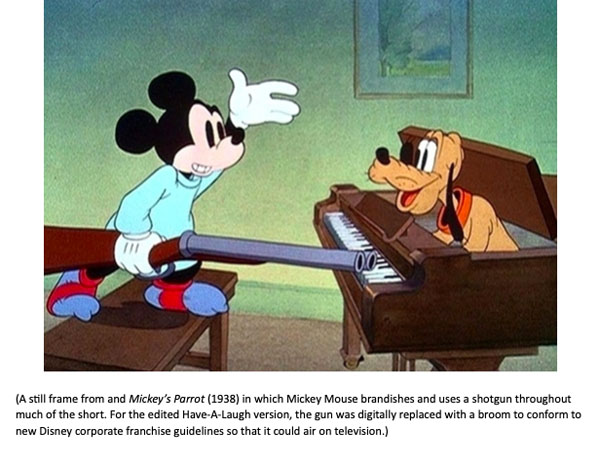
The characters on the point-of-purchase display card are the pie-eyed versions indicative of the mid-1930s. Although I like this design period at Disney, nothing beats the eye-appeal of the Fred Moore re-design of Mickey Mouse for The Sorcerer’s Apprentice that appeared several years later in the release of Fantasia (1940).
To the right of the characters is the text “HI, FELLERS! HERE’S YOUR MICKEY MOUSE POCKET KNIFE” with “KEEN STEEL BLADES” in a small font beneath. Below the text is a white square box outlined in red where the merchant could write in the price that they sold the pocket knives for at their store. This top portion of the display was also used for 8 ½ X 10 ½ notepaper, presumably a premium for the retailer.(5)
These Mickey Mouse pocket knives appeared in the Herman “Kay” Kamen Disney catalog that displayed all the official Disney licensed merchandise during that period. Kamen had the licensing agreement for all the Disney merchandise and helped promote the Disney characters on various products, including developing the first Mickey Mouse watch.(6) An entire book can and should be written about Kay Kamen, his relationship with Walt and Roy O. Disney, and his merchandising and marketing genius. My focus for the piece is just on the Mickey Mouse pocket knife and related advertising ephemera.
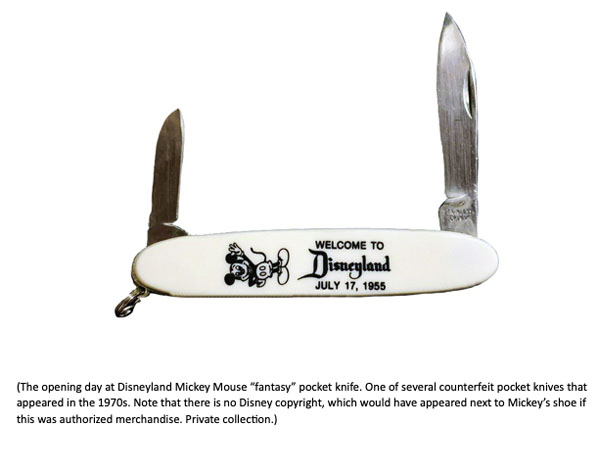
The interesting thing about the Mickey Mouse pocket knife is that several fake or “fantasy” pocket knives have appeared in the marketplace over the years. The most notable is the 1933 World Fair and opening day of Disneyland pocket knives, both featuring Mickey Mouse. “A pocket knife or any other item with Mickey Mouse and a 1933 World Fair imprint cannot be original Disney merchandise,” according to Dave Smith (1940—2019), Disney Archivist, in an interview many years ago. He went on to state, “the knives were “fantasy” items, a term used for new merchandise without any old counterpart.”(7) In other words, the 1933 World Fair and Disneyland opening day Mickey Mouse pocket knives are unauthorized knockoffs— counterfeit merchandise.
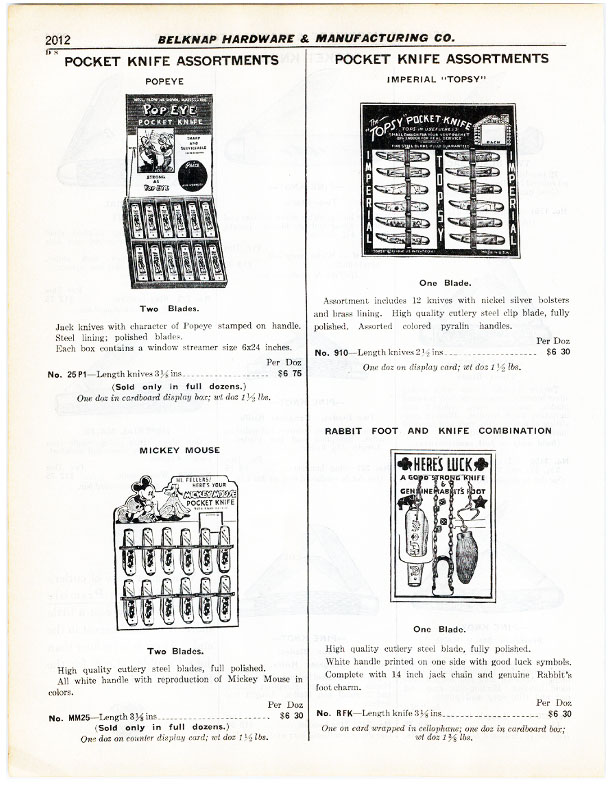
A page out of the Belknap Hardware & Manufacturing Co. catalog that shows the Popeye (top left) and Mickey Mouse (bottom left) Pocket Knife displays, with both sold wholesale “only in full dozens. Private collection.
When Disney-related items are offered for sale, it is best to do your research. The “1933 World Fair Mickey Mouse” pocket knives appeared on the market in the 1970s(8) and have been around for so long that many believe them authentic. They are not. That is a blow to any collector who paid a hundred or even several hundred dollars for one thinking it was the real deal.
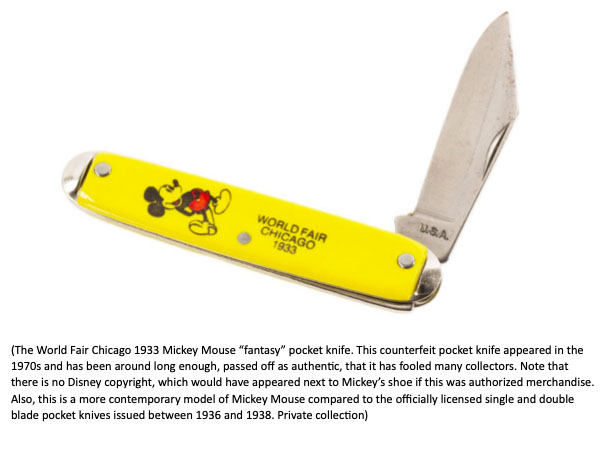
Knockoffs and counterfeit merchandise are a common problem with famous brands and especially Disney characters. I have spotted many counterfeit Disney merchandise items in my travels, whether at a street market in Mexico City, a night market in Hanoi, Vietnam, a ramshackle shop in Jakarta, Malaysia, or anywhere cash-based commerce is taking place around the world. Many of these items are easy to spot because the characters are grossly off-model, but there are other items where the characters are spot-on, and it is difficult to determine whether or not the thing is counterfeit. Caveat emptor—buyer beware!
It is crucial as a collector to know what you are buying. Just because someone says the item is authentic doesn’t mean it is. The other critical aspect of research is to use multiple sources whenever possible. Yet, even then, you can still be burned with a fake or “fantasy” item. Unless, of course, you are actively collecting counterfeit merchandise, which is certainly a worthwhile pursuit for Disney branded items.
For those just starting, there are numerous auction houses for Disney collectibles, like Heritage Auctions, Hake’s Auctions, Van Eaton Galleries, and others, with their vast libraries of past auction results where valuable information can be gleaned in item descriptions. Reference books like Tomart’s Illustrated Disneyana Catalog and Price Guide or The Official Price Guide to Disney Collectibles by Ted Hake, among others, offer a wealth of information for collectors in understanding the origins, varieties, editions, values, etc. of Disney collectibles.
Ultimately, when collectors decide to make a purchase, they hopefully do it because it brings them enjoyment, which is what collecting is all about. You simply enjoy accumulating a collection of items that strike a chord with you, your interests, and that spark curiosity and your imagination. If the collection is built over years or decades and happens to garner intrinsic value, that is the icing on the cake. After all, collectors are merely keepers of an item for a specific period before passing them on to the next collector for safekeeping and so forth along the time continuum.
©2021 David A. Bossert
Footnotes
1 Swiss Knife Shop, https://www.swissknifeshop.com/products/huntsman-swiss-army-knife
2 Knife Country USA, https://www.knifecountryusa.com/store/product/207864.207893/schrade-11uh-uncle-henry-large-canoe-folding-pocket-knife-with-staglon-handle.html
3 Tom Tumbusch (1985), Tomart’s Illustrated Disneyana Catalog and Price Guide.
4 Mickey Mouse Pocket Knife point-of-purchase display, Private Collection.
5 ibid
6 Alan Bryman (2004). The Disneyization of Society. p. 83.
7 Mark Chervenka, All 1933 Worlds [sic] Fair Mickey Mouse Knives are Fake, Real or Repo, 1998-2021.
8 Ibid, Tom Tumbusch quote.


 David A. Bossert is an award-winning artist, filmmaker, and author. He received his B.A. from CalArts School of Film and Video with a major in Character Animation. As a 32-year veteran of The Walt Disney Company, he contributed his talents to The Black Cauldron (1985), Who Framed Roger Rabbit (1988), The Little Mermaid (1989), Beauty and the Beast (1991), Aladdin (1992), Tim Burton’s The Nightmare Before Christmas (1993), The Lion King (1995), Fantasia/2000 (1999), and the Academy Award-nominated shorts Runaway Brain (1995), Dali/Disney Destino (2003), and Lorenzo (2004), among many others. Bossert is now an independent producer, creative director, and writer.
David A. Bossert is an award-winning artist, filmmaker, and author. He received his B.A. from CalArts School of Film and Video with a major in Character Animation. As a 32-year veteran of The Walt Disney Company, he contributed his talents to The Black Cauldron (1985), Who Framed Roger Rabbit (1988), The Little Mermaid (1989), Beauty and the Beast (1991), Aladdin (1992), Tim Burton’s The Nightmare Before Christmas (1993), The Lion King (1995), Fantasia/2000 (1999), and the Academy Award-nominated shorts Runaway Brain (1995), Dali/Disney Destino (2003), and Lorenzo (2004), among many others. Bossert is now an independent producer, creative director, and writer.













































































I’m reminded of an incident I read about in a biography of H. P. Lovecraft. His wife once declared at a party that no true gentleman would ever carry a pocketknife — whereupon every man present, Lovecraft included, produced his.
The pocket knife that has served me for the past 30 years was a premium I got for sending in cigarette coupons; it has the “Marlboro Country Store” logo stamped onto the side. I seldom use the blade, but the three screwdrivers, can opener and wire cutters really come in handy. It bothers me that I can’t carry it legally in certain jurisdictions, for example on commuter trains. I do it anyway, but if they ever put up metal detectors I’ll be stuffed.
I, too, had a Boy Scout knife in my Scouting days, and I also used one at a summer job in a factory where I trimmed pieces of insulation for truck dashboards. I had to sharpen the blade several times a day. I think any kid in my Boy Scout troop who showed up with a Mickey Mouse pocketknife would have been lucky not to get his ass kicked.
You’re quite right about the prevalence of counterfeit merchandise. I once saw a “Two-Gun Mickey” toy gun set: the holster was stamped with an image of Mickey Mouse in a cowboy costume, but there was no Walt Disney copyright imprint, and the guns were standard Hubley cap pistols with no distinguishing Disney features. Were there ever any officially licensed Mickey Mouse toy guns?
Hi Paul, Thanks for reading the article and for your comments. In regards to your question, were there ever any officially licensed Mickey Mouse toy guns? I don’t know the answer to this as it would require some research. I have seen the Mickey Mouse Club Mouseketeer Special Deputy squirt gun and the Mickey Mouse holsters with the cap pistols, but don’t know if those are officially licensed merchandise or not. Maybe one of the readers might know.
Thank you,
-Dave
Oh well, at least they weren’t offering Mickey Mouse Glock 19s.
For decades I’ve carried a bare-bones 3″ Swiss Army whose most-used tools are a corkscrew and bottle opener. And of course these days it must be left behind if I’m visiting the airport or a government building.
So I just don’t go anywhere.
HA!
For one thing, the illustration on that fake World’s Fair Chicago 1933 knife actually comes from the late 1934-1935 United Artists period. Another way to spot that the knife is fake.
The typography on that knife is all wrong for the period, that should be “World’s Fair,” not “World Fair,” and I’ll bet that a genuine article from that Fair would have “Century of Progress” on it. No one should be taken in by it.
Now they check your bags at Disneyland, once you get off the tram from the parking lot, to make sure you’re not packing your “Welcome to Disneyland” pocketknife (or similar souvenirs).
There is some info an Kay Kaymen and his relationship with, Walt, Roy & the Company in the books…Walt Disney the American Dreamer and Merchandise History of Disneyana – Disney Merchandise of the 1930s, both by Tomart Publishing. These can be found on Amazon.